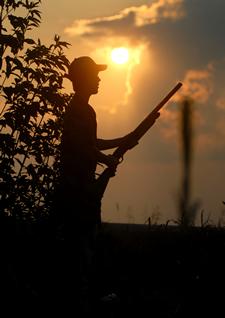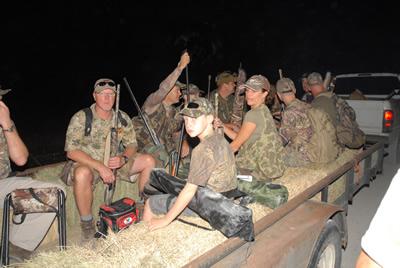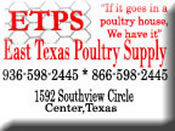 September 1, 2017 - The September 1 opener of dove season is always a big deal with Texas hunters, but it will be especially big this year because opening day falls on a Friday. For those lucky enough to escape the wrath of Harvey, it could mean a four-day hunting weekend with the September 4 Labor Day holiday figured in.
September 1, 2017 - The September 1 opener of dove season is always a big deal with Texas hunters, but it will be especially big this year because opening day falls on a Friday. For those lucky enough to escape the wrath of Harvey, it could mean a four-day hunting weekend with the September 4 Labor Day holiday figured in.
If that's not reason enough to celebrate, I don't know what is. Just play it smart out there and don't get so caught up in the all the excitement that you let your guard down or make a serious mistake that you can't take back.
Dove hunters tote shotguns loaded with shotshells capable of throwing a spray of lead pellets a considerable distance before they fall to the ground under the laws of gravity.
Shotguns are deadly weapons at close range, even when loaded with light field loads. They can cause serious injuries at long range, too. One stray pellet could put somebody's eye out from 100 yards away, possibly farther.
There were 24 hunting-related accidents reported in Texas last year, 14 of them involving shotguns. Five of the accidents were fatal and 19 non-fatal.
 Dove hunters were involved in more of those accidents (7) than hunters of any other game. Quail hunters accounted for the second highest total with four.
Dove hunters were involved in more of those accidents (7) than hunters of any other game. Quail hunters accounted for the second highest total with four.
Dove and quail hunters are typically shooting at flying targets that are prone to dart, dive or change flight course erratically. Some bird hunters get so caught up in tracking the birds that they forget where their hunting buddies are at.
Bad things can happen if the trigger is pulled at the same time the shotgun muzzle crosses paths with another hunter in the line of fire.
Poor hunter judgement has a long history of being a major contributor of hunting related accidents in Texas, and the trend continued last year.
Five accidents came as the result of swinging on game outside the safe zone of fire and another five happened because the victim was out of sight or moved into the line of fire. Two more involved hunters who were shot after being mistaken for game.
A quick review of Texas Parks and Wildlife's 2016 Texas Hunting Incidents Analysis report shows just how quickly accidents can happen out there. Here is a synopsis the reported incidents involving dove hunters and how the accidents may have been prevented.
* Accident 1 (Fatality)
How it Happened: Right after firing a shot from his double-barrel shotgun, the shooter turned towards victim with a loaded second barrel, which went off just as the muzzle was pointed at the victim. The shot pellets penetrated victim’s right back torso at extremely close range.
Prevention: Always point muzzle in a safe direction; keep your finger outside the trigger guard until you are ready to shoot. Remember that in semi-automatic and double-barrel firearms, the chamber may be loaded immediately after taking a shot and that the ‘safety’ is usually in the ‘off’ position.
* Accident 2 (Non-Fatality)
How it Happened: Shooter shot at a dove, and as he went to retrieve it, the dove flew away. The shooter again swung on the dove, but this time outside of a safe zone of fire, towards the victim who was standing in a nearby ditch. About 25 pellets struck victim in head and upper torso from 50-60 yards.
Prevention: Always maintain a safe zone of fire; communicate with hunting companions; know where others are positioned at all times; make sure to identify the target clearly; identify what is in front of and behind the target before shooting.
* Accident 3 (Non-Fatality)
How it Happened: Victim was “peppered” by pellets by an unknown shooter, causing bleeding from his neck area.
Prevention: Same as above.
* Accident 4 (Non-Fatality)
How it Happened: Shooter swung on victim outside of his safe zone of fire. Victim was sitting behind some cover and was struck by pellets in his upper right shoulder area from about 25-30 yards.
Prevention: Same as above.
* Accident 5 (Non-Fatality)
How it Happened: The victim was retrieving a downed bird when he was peppered by pellets by an unknown shooter.
Prevention: Same as above.
* Accident 6 (Non-Fatality)
How it Happened: Victim was in the line of fire of three other hunters and was struck by a pellet in his eye. It was determined that the pellet came from one of the hunter’s direct line of fire; however, it could possibly have come from all three of the other hunter’s shotgun blasts. Alcohol may have played a role in the incident.
Prevention: Same as above; avoid using alcohol and drugs.
* Accident 7 (Non-Fatality)
How it Happened: Shooter had loaded shotgun on the ground between him and victim and it discharged as he picked it up, shooting the victim in his right buttocks.
Prevention: Always point muzzle in a safe direction; keep your finger outside the trigger guard until you are ready to shoot; handle firearms carefully; always unload before placing firearm on the ground or against a secure rest.
The message here is for hunters to use their heads out there. Watch out for others and watch out for yourself.
Dove hunters can reduce the odds of being involved in an accident by careful positioning and communicating among themselves. Never set up in front of or behind another hunter. Speak up if you see a shooter move into a location that could put you or someone else in the line of fire. If the shooter refuses to change locations, move yourself.
Dove hunters should space out in a horizontal line a considerable distance apart. Multiple hunters positioned too close together or in a crossfire is a recipe for disaster.
Dove hunting is a fun sport. Hunters can enhance the experience by doing their part by doing some police work to make sure the field is kept safe for themselves as well as others.









